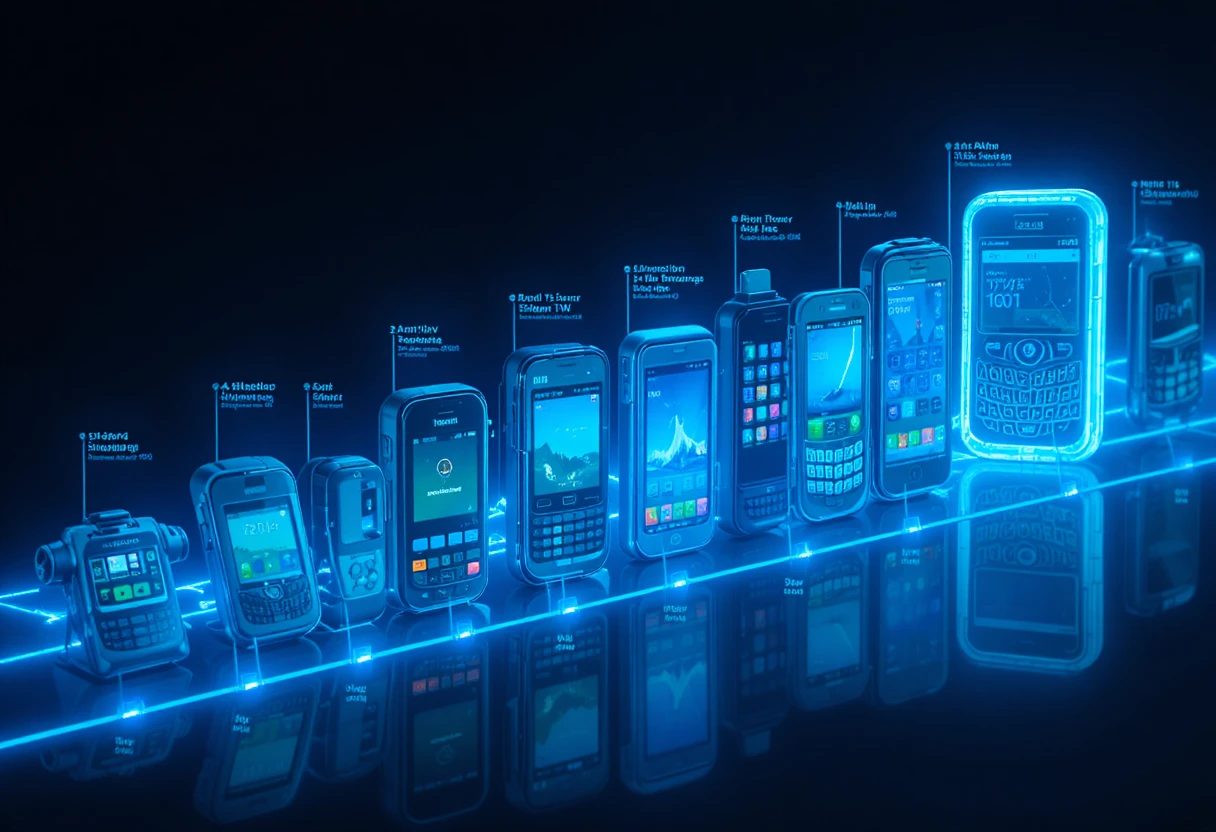Smartphones have become indispensable tools in the digital age, transforming how we communicate, work, and live. These pocket-sized devices combine computing power, connectivity, and versatility, making them central to personal and professional life. From enabling instant communication to powering advanced applications like augmented reality and mobile banking, smartphones are at the forefront of technological innovation. This 3000-word article explores the fundamentals, applications, challenges, and future of smartphones, offering a comprehensive overview of their profound impact.
What are Smartphones?
A smartphone is a portable electronic device that combines mobile telephony, computing capabilities, and internet connectivity. Unlike traditional mobile phones, smartphones feature advanced operating systems (e.g., iOS, Android), touchscreens, cameras, and a wide range of applications. They serve as communication hubs, entertainment devices, productivity tools, and gateways to the digital world, integrating technologies like GPS, sensors, and high-speed networks.
A Brief History of Smartphones
The smartphone’s origins trace back to the 1990s with devices like IBM’s Simon Personal Communicator (1994), which combined a mobile phone with PDA features. The early 2000s saw BlackBerry dominate with its email-focused devices. The modern smartphone era began in 2007 with Apple’s iPhone, introducing a touchscreen interface and an app ecosystem. Google’s Android platform, launched in 2008, democratized smartphones, leading to widespread adoption.
By the 2010s, smartphones became ubiquitous, with advancements in processors, displays, and cameras. Today, smartphones leverage 5G, artificial intelligence (AI), and foldable designs, continuing to redefine technology’s role in society.

How Smartphones Work: Core Components
Smartphones are complex systems integrating hardware, software, and connectivity to deliver seamless functionality.
Hardware
Smartphones comprise several key hardware components:
- Processor (SoC): The System on a Chip (SoC), like Qualcomm Snapdragon or Apple A-series, acts as the brain, handling computations and graphics.
- Display: High-resolution AMOLED or LCD touchscreens provide vibrant visuals and intuitive interfaces.
- Camera: Multi-lens camera systems with advanced sensors enable high-quality photography and video.
- Battery: Lithium-ion batteries power devices, with fast-charging technologies improving efficiency.
- Sensors: Accelerometers, gyroscopes, GPS, and proximity sensors enable features like navigation and motion tracking.
Operating Systems
Smartphone operating systems, primarily Apple’s iOS and Google’s Android, manage hardware and software interactions. iOS offers a closed, optimized ecosystem, while Android provides open-source flexibility, powering devices from brands like Samsung, Xiaomi, and OnePlus.
Connectivity
Smartphones support multiple connectivity options, including 5G, Wi-Fi, Bluetooth, and NFC (Near Field Communication). These enable high-speed internet, wireless audio, and contactless payments.
Applications (Apps)
Apps extend smartphone functionality, from social media (e.g., WhatsApp, Instagram) to productivity tools (e.g., Microsoft Office, Google Docs). App stores like Apple’s App Store and Google Play host millions of apps, catering to diverse needs.
Security Features
Smartphones incorporate biometric authentication (fingerprint scanners, facial recognition), encryption, and secure boot processes to protect user data. Features like Apple’s Face ID and Android’s Titan M chip enhance security.
Types of Smartphones
Smartphones vary in design, features, and target audiences, catering to different preferences and budgets.
Flagship Smartphones
Flagship devices, like the iPhone 16 Pro or Samsung Galaxy S24 Ultra, offer cutting-edge technology, premium materials, and advanced features like AI enhancements and professional-grade cameras.
Mid-Range Smartphones
Mid-range smartphones, such as the Google Pixel 8a or Xiaomi Redmi Note, balance performance and affordability, offering robust features for budget-conscious consumers.
Budget Smartphones
Budget smartphones, like the Moto G series or Realme devices, provide essential functionality at low costs, making them popular in emerging markets.
Foldable Smartphones
Foldable smartphones, such as the Samsung Galaxy Z Fold or Huawei Mate X, feature flexible displays, enabling new form factors for multitasking and portability.
Rugged Smartphones
Rugged smartphones, like the CAT S62 or Doogee S98, are designed for durability, with water, dust, and drop resistance, catering to outdoor and industrial users.
Applications of Smartphones
Smartphones have transformed industries and daily life, serving as multifunctional devices with vast applications.
Communication
Smartphones enable instant communication through calls, texts, emails, and apps like WhatsApp, Telegram, and Zoom. Video conferencing and social media platforms like Instagram and X connect people globally.
Entertainment
Smartphones are entertainment hubs, supporting streaming (Netflix, Spotify), gaming (Genshin Impact, PUBG Mobile), and content creation (TikTok, YouTube). High-quality displays and audio enhance media experiences.
Productivity
Smartphones boost productivity with apps for email, calendars, document editing, and project management. Tools like Microsoft Office and Trello enable remote work and collaboration.
Photography and Videography
Smartphone cameras rival professional equipment, with features like night mode, ultra-wide lenses, and 8K video recording. Apps like Adobe Lightroom and CapCut enhance creative output.
Mobile Banking and Payments
Smartphones facilitate secure financial transactions through apps like PayPal, Google Pay, and Apple Pay. NFC enables contactless payments, while blockchain-based apps support cryptocurrency transactions.
Healthcare
Smartphones support health monitoring through apps and wearables. Fitness apps like Strava track activity, while telemedicine platforms connect patients with doctors. Devices like the Samsung Galaxy integrate health sensors for heart rate and ECG monitoring.
Navigation and Travel
GPS-enabled smartphones provide real-time navigation via apps like Google Maps and Waze. Travel apps, such as Booking.com and Uber, simplify trip planning and transportation.

Benefits of Smartphones
Smartphones offer numerous advantages, making them essential in modern life.
Connectivity and Accessibility
Smartphones provide instant access to information and communication, connecting users globally. They bridge geographical gaps, enabling remote work and social interaction.
Versatility
Smartphones combine multiple functions—phone, camera, computer, GPS—into one device, reducing the need for separate gadgets.
Portability
Compact and lightweight, smartphones are easy to carry, ensuring constant access to tools and services.
Personalization
Customizable interfaces, apps, and settings allow users to tailor smartphones to their preferences, enhancing user experience.
Economic Impact
Smartphones drive economic growth by enabling e-commerce, digital payments, and app-based businesses, particularly in emerging markets.
Challenges in Smartphones
Despite their benefits, smartphones face challenges that impact users and industries.
Security and Privacy
Smartphones store sensitive data, making them targets for cyberattacks like phishing, malware, and data breaches. Robust encryption and user awareness are critical to mitigate risks.
Battery Life
High-performance features drain batteries quickly. While fast charging and power-efficient chips help, battery life remains a concern for heavy users.
Digital Addiction
Overuse of smartphones, particularly social media and gaming apps, can lead to addiction, impacting mental health and productivity. Screen-time management tools aim to address this.
E-Waste and Sustainability
The rapid turnover of smartphone models contributes to electronic waste. Sustainable manufacturing and recycling programs are needed to reduce environmental impact.
Cost and Accessibility
Flagship smartphones are expensive, creating barriers for low-income users. Affordable alternatives exist, but feature gaps can exacerbate the digital divide.
Planned Obsolescence
Manufacturers may limit software updates or design devices with short lifespans, encouraging frequent upgrades. This raises ethical and environmental concerns.
Ethical Considerations
Smartphones raise ethical questions that require careful consideration to balance innovation and societal impact.
Privacy and Data Security
Smartphones collect vast amounts of personal data, raising privacy concerns. Transparent data policies and user control over data sharing are essential to build trust.
Digital Divide
Uneven smartphone adoption, particularly in developing regions, exacerbates inequality. Affordable devices and infrastructure investments can bridge this gap.
Mental Health
Prolonged smartphone use is linked to anxiety, depression, and reduced attention spans. Ethical app design and user education can promote healthy usage habits.
Environmental Sustainability
Smartphone production and disposal contribute to environmental degradation. Manufacturers must adopt eco-friendly materials and recycling initiatives.

The Future of Smartphones
The future of smartphones is shaped by emerging technologies and evolving user needs.
Foldable and Flexible Displays
Foldable smartphones and flexible screens will become mainstream, offering new form factors for productivity and entertainment. Devices like the Samsung Galaxy Z Fold are leading this trend.
5G and Beyond
5G connectivity enables faster data speeds and low-latency applications, such as AR gaming and real-time collaboration. Research into 6G promises even greater advancements by 2030.
AI and Machine Learning
AI will enhance smartphone capabilities, from smarter cameras to personalized assistants. On-device AI, like Google’s Tensor chip, will improve performance and privacy.
Augmented Reality (AR) and Virtual Reality (VR)
Smartphones will integrate AR and VR for immersive experiences, such as gaming, virtual try-ons, and remote collaboration, supported by powerful chipsets and 5G.
Sustainability Initiatives
Manufacturers will prioritize eco-friendly designs, using recyclable materials and extending device lifespans through modular components and longer software support.
Health and Wellness Integration
Smartphones will expand health monitoring, integrating advanced sensors for blood oxygen, stress, and sleep tracking. Apps will offer personalized wellness recommendations.
Seamless Ecosystems
Smartphones will integrate more seamlessly with IoT devices, wearables, and smart homes, creating cohesive ecosystems controlled via a single device.
Conclusion
Smartphones are the cornerstone of modern connectivity, blending communication, entertainment, and productivity into compact, powerful devices. Their applications in healthcare, finance, education, and beyond demonstrate their transformative impact. However, challenges like privacy, sustainability, and digital addiction must be addressed to ensure responsible use. As technologies like 5G, AI, and foldable displays shape the future, smartphones will continue to evolve, driving innovation and connectivity. Collaboration between manufacturers, policymakers, and users will be crucial to harness their potential, creating a future where smartphones empower and unite society equitably.
